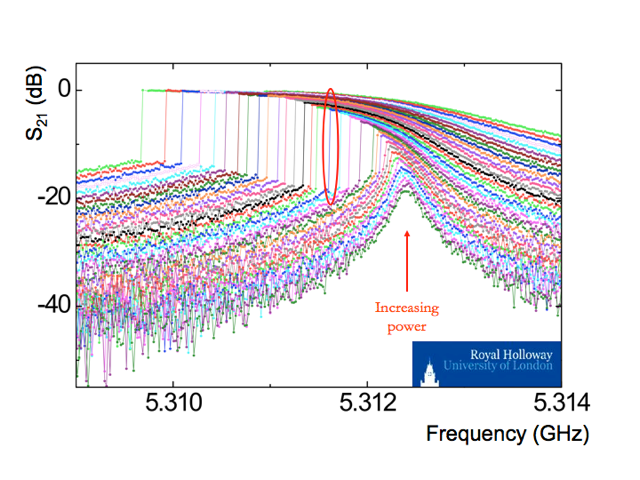REG(RHUL): Measurement and control of few and single photon microwave radiation via non-linear bifurcation technologies
REG contact person: Dr Phil Meeson

Perhaps the most demanding regime of single-photon microwave emission, control and detection is that near 10 GHz, because of the very low photon energies involved. One approach to enhance photon detection sensitivity is through bifurcation phenomena. The REG will focus on the development of two types of bifurcation amplifier. We will also co-develop a single photon emitter based on the relaxation of a qubit embedded in a superconducting co-planar waveguide and aim to integrate the emission and detection technologies.
The amplitude bifurcation amplifier is a form of threshold detector. Such an amplifier depends on (cubic) non-linearities being introduced into an externally pumped high-Q resonator dividing the response into two metastable and hysteretic states. The linewidth of the resonance is usually regarded as a measure of the available sensitivity of the resonator, however with a bifurcating amplifier hysteretic switching may occur between the two states with an onset much smaller than the linewidth, providing a much greater sensitivity, at the expense of resolution.
A new type of superconducting bifurcation amplifier has recently been suggested based on a quadratic non-linearity. A sharp onset of oscillations at the half-frequency of the drive should allow the detection of small variations of coupled sample parameters such as the photon occupancy of a coupled resonant mode. The theoretical bifurcation characteristics of this circuit compare well with those of the conventional Josephson amplitude bifurcation amplifier.
Such devices are complicated quantum dynamical devices and the aim in both cases is to make the switching between dynamical states optimally sensitive to the presence of microwave photons, even to the single photon level. If achieved this would have potential extensions to fundamental issues such as quantum non-demolition detection, the squeezing of noise below the standard quantum limit and other possibilities. We will focus on experimental development and testing to establish proof-of-principle and the practical limitations of devices and design compromises.
The REG will work closely with PTB, NPL and other members of the consortium to achieve these aims.

The research within this EURAMET joint research project receives funding from the European Community's Seventh Framework Programme, ERA-NET Plus, under Grant Agreement No. 217257.
For more information, please contact the project coordinator, Dr Antti Manninen from MIKES
